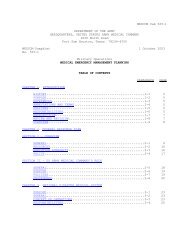(MCD) Guidelines
(MCD) Guidelines
(MCD) Guidelines
Create successful ePaper yourself
Turn your PDF publications into a flip-book with our unique Google optimized e-Paper software.
<strong>Guidelines</strong> for Military Mass Casualty Decontamination Operations<br />
During a Domestic HAZMAT/Weapon of Mass Destruction Incident<br />
civilian response operations, such as surveillance/monitoring and decontamination,<br />
as described in Section 3.0.<br />
U.S. Army and U.S. Marine Corps (USMC) tactical units, at battalion level and<br />
above, have an organic radiological detection capability, and monitoring and survey<br />
capability. Radiological survey and monitoring has been a mission since these<br />
organizations were established. These organizations have the equipment, training,<br />
and experience necessary for alpha, beta, and gamma detection, particularly within<br />
the USMC CBIRF. The U.S. Air Force (USAF) has personnel trained to operate<br />
radiation, detection, indication, and computation (RADIAC) detection equipment and<br />
to perform radiological monitoring and surveys.<br />
Most Navy ships have organic radiological monitoring and survey capability. U.S.<br />
Navy afloat surface forces and larger naval shipyards are outfitted with an array of<br />
radiological detection and monitoring equipment. Through land-based radiation<br />
technicians and ship-based laboratory technicians, afloat forces, and all nuclearpowered<br />
vessels, Navy personnel can rapidly detect airborne, waterborne, and solid<br />
mass radioactive sources or inadvertent releases. Navy personnel also respond<br />
accordingly to warn and protect people in the immediate vicinity until relieved by<br />
civilian responders. If the attack occurs while the vessel is transiting open waters,<br />
the ship’s crew assumes a defensive posture. The crew decontaminates exposed<br />
exterior surfaces and personnel to the maximum extent possible before entering any<br />
civilian ports or restricted waters. Section 8.3.9 provides specific details on such<br />
decontamination.<br />
Section 8.4.3 provides more information on radiological-specific decontamination<br />
guidelines. Appendix E lists dose rates and symptoms of radiation exposure.<br />
6.0 Comparison Between Military and Civilian <strong>MCD</strong><br />
Equipment<br />
INTENT: Provide a cross-reference guide that compares <strong>MCD</strong>, detection, and<br />
protective equipment for military and civilian responders.<br />
The Cross-Reference Guide, presented in Appendix D, compares military<br />
decontamination equipment to that available to civilian responders. Military<br />
personnel will have an idea of the types of equipment they might encounter when<br />
providing assistance to civilians during a mass casualty incident. Types of<br />
equipment compared include <strong>MCD</strong>, detection, and individual protective equipment<br />
(IPE) and personal protective equipment (PPE). Appendix D provides information on<br />
capabilities, limitations, and operational specifications of some common equipment<br />
civilian responders’ use.<br />
The military equipment list provides an example of a well-supplied Army element<br />
with significant <strong>MCD</strong> capabilities. Actual elements could have more or less of the<br />
<strong>MCD</strong> equipment listed. The civilian responder equipment listed in Appendix D was<br />
compiled from sources such as Lessons Learned Information Sharing (LLIS),<br />
12 Original



